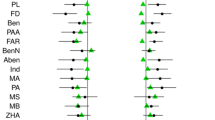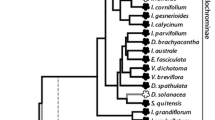Abstract
Analyzing the evolution of complex traits requires multiple tools and perspectives. Here, we consider one perception that complex trait is a system that undergoes multiple transformations involving factors both genetic and environmental. By carefully dissecting the genetic basis of a complex trait and examining how the genetic basis responds to the natural environment and the consequences, we argue that the genetic components of a complex trait and their interactions are inherently information-rich for evolutionary studies if we know what kind of data to gather. We take the anthocyanin pathway in Ipomoea purpurea flower as a model to analyze how the natural environment regulates the flower color and how the gene expression is modified to provide the biochemical substance for the phenotype. As summarized here with multidisciplinary data, the relationship between genotype and phenotype is likely to be elucidated for the complex trait of floral color in the foreseeable future.
Access this chapter
Tax calculation will be finalised at checkout
Purchases are for personal use only
Similar content being viewed by others
References
Alfenito MR, Souer E, Goodman CD, Buell R, Mol J, Koes R, Walbot V (1998) Functional complementation of anthocyanin sequestration in the vacuole by widely divergent glutathione S-transferases. Plant Cell 10:1135–1149
Alroy J (1998) Cope’s rule and the dynamics of body mass evolution in North American fossil mammals. Science 280:731–734
Arroyo-Garcia R, Ruiz-Garcia L, Bolling L, Ocete R, Lopez MA, Arnold C, Ergul A, Soylemezoglu G, Uzun HI, Cabello F, Ibanez J, Aradhya MK, Atanassov A, Atanassov I, Balint S, Cenis JL, Costantini L, Goris-Lavets S, Grando MS, Klein BY, McGovern PE, Merdinoglu D, Pejic I, Pelsy F, Primikirios N, Risovannaya V, Roubelakis-Angelakis KA, Snoussi H, Sotiri P, Tamhankar S, This P, Troshin L, Malpica JM, Lefort F, Martinez-Zapater JM (2006) Multiple origins of cultivated grapevine (Vitis vinifera L. ssp sativa) based on chloroplast DNA polymorphisms. Mol Ecol 15:3707–3714
Atchley WR, Terhalle W, Dress A (1999) Positional dependence, cliques, and predictive motifs in the bHLH protein domain. J Mol Evol 48:501–516
Avargues-Weber A, Deisig N, Giurfa M (2011) Visual cognition in social insects. Annu Rev Entomol 56:423–443
Biolley J, Jay M (1993) Anthocyanins in modern roses—chemical and colorimetric features in relation to the color range. J Exp Bot 44:1725–1734
Bradshaw HD, Schemske DW (2003) Allele substitution at a flower colour locus produces a pollinator shift in monkeyflowers. Nature 426:176–178
Briscoe AD, Chittka L (2001) The evolution of color vision in insects. Annu Rev Entomol 46:471–510
Campbell AD, Huysamer M, Stotz HU, Greve LC, Labavitch JM (1990) Comparison of ripening processes in intact tomato fruit and excised pericarp disks. Plant Physiol 94:1582–1589
Chalker-Scott L (1999) Environmental significance of anthocyanins in plant stress responses. Photochem Photobiol 70:1–9
Chappell J, Hahlbrock K (1984) Transcription of plant defense genes in response to uv-light or fungal elicitor. Nature 311:76–78
Chittka L (1996) Does bee color vision predate the evolution of flower color? Naturwissenschaften 83:136–138
Christie PJ, Alfenito MR, Walbot V (1994) Impact of low-temperature stress on general phenylpropaniod and anthocyanin pathways:enhancement of transcript abundance and anthocyanin pigmentation in maize seedlings. Planta 194:541–549
Clegg MT, Durbin ML (2003) Tracing floral adaptations from ecology to molecules. Nat Rev Genet 4:206–215
Conn S, Franco C, Zhang W (2010) Characterization of anthocyanic vacuolar inclusions in Vitis vinifera L. cell suspension cultures. Planta 231:1343–1360
Darwin C (1859) On the origin of species by means of natural selection. John Murray, London
Debeaujon I, Peeters AJM, Leon-Kloosterziel KM, Koornneef M (2001) The TRANSPARENT TESTA12 gene of Arabidopsis encodes a multidrug secondary transporter-like protein required for flavonoid sequestration in vacuoles of the seed coat endothelium. Plant Cell 13:853–871
Des Marais DL, Rausher MD (2008) Escape from adaptive conflict after duplication in an anthocyanin pathway gene. Nature 454:762–U785
DeWitt TJ, Scheiner SM (2004) Phenotypic plasticity. Oxford University Press, Oxford
Dixon DP, Skipsey M, Edwards R (2010) Roles for glutathione transferases in plant secondary metabolism. Phytochemistry 71:338–350
Durbin ML, Lundy KE, Morrell PL, Torres-Martinez CL, Clegg MT (2003) Genes that determine flower color: the role of regulatory changes in the evolution of phenotypic adaptations. Mol Phylogenet Evol 29:507–518
Emerson RA (1921) The genetic relations of plant colors in maize. Cornell University Press, New York
Foster JB (1964) Evolution of mammals on islands. Nature 202:234–235
Glover BJ, Martin C (1998) The role of petal cell shape and pigmentation in pollination success in Antirrhinum majus. Heredity 80:778–784
Harborne JB, Baxter H (1999) The handbook of natural flavonoids. vol 1 and 2. Wiley, New York, p 644 and p 236
Harborne JB, Williams CA (2000) Advances in flavonoid research since 1992. Phytochemistry 55:481–504
Hering E (1964) Outline of the theory of light sense. Harvard University Press, Cambridge
Hosokawa K (1999) Cell layer-specific accumulation of anthocyanins in response to gibberellic acid in tepals of Hyacinthus orientalis. Biosci Biotechnol Biochem 63:930–931
Jacobs GH (2009) Evolution of colour vision in mammals. Philos Trans R Soc Lond B Biol Sci 364:2957–2967
Kelber A, Osorio D (2010) From spectral information to animal colour vision: experiments and concepts. Proc Biol Sci 277:1617–1625
Koes R, Verweij W, Quattrocchio F (2005) Flavonoids: a colorful model for the regulation and evolution of biochemical pathways. Trends Plant Sci 10:236–242
Kramer EM, Hodges SA (2010) Aquilegia as a model system for the evolution and ecology of petals. Philos Trans R Soc Lond B Biol Sci 365:477–490
Kubasek WL, Shirley BW, McKillop A, Goodman HM, Briggs W, Ausubel FM (1992) Regulation of flavonoid biosynthetic genes in germinating arabidopsis seedlings. Plant Cell 4:1229–1236
Lei MG, Zhu CM, Liu YD, Karthikeyan AS, Bressan RA, Raghothama KG, Liu D (2011) Ethylene signalling is involved in regulation of phosphate starvation-induced gene expression and production of acid phosphatases and anthocyanin in Arabidopsis. New Phytol 189:1084–1095
Lipsick JS (1996) One billion years of Myb. Oncogene 13:223–235
Lu Y, Du J, Tang J, Wang F, Zhang J, Huang J, Liang W, Wang L (2009) Environmental regulation of floral anthocyanin synthesis in Ipomoea purpurea. Mol Ecol 18:3857–3871
Markham KR, Gould KS, Winefield CS, Mitchell KA, Bloor SJ, Boase MR (2000) Anthocyanic vacuolar inclusions—their nature and significance in flower colouration. Phytochemistry 55:327–336
Marrs KA, Alfenito MR, Lloyd AM, Walbot V (1995) A glutathione-S-transferase involved in vacuolar transfer encoded by the maize gene bronze-2. Nature 375:397–400
Martin C, PazAres J (1997) MYB transcription factors in plants. Trends Genet 13:67–73
Miller R, Owens SJ, Rorslett B (2011) Plants and colour: flowers and pollination. Opt Laser Technol 43:282–294
Millien V (2006) Morphological evolution is accelerated among island mammals. PLoS Biol 4:1863–1868
Mori K, Goto-Yamamoto N, Kitayama M, Hashizume K (2007) Loss of anthocyanins in red-wine grape under high temperature. J Exp Bot 58:1935–1945
Mueller LA, Goodman CD, Silady RA, Walbot V (2000) AN9, a petunia glutathione S-transferase required for anthocyanin sequestration, is a flavonoid-binding protein. Plant Physiol 123:1561–1570
Noda K, Glover BJ, Linstead P, Martin C (1994) Flower color intensity depends on specialized cell-shape controlled by a myb-related transcription factor. Nature 369:661–664
Nozaki K, Takamura T, Fukai S (2006) Effects of high temperature on flower colour and anthocyanin content in pink flower genotypes of greenhouse chrysanthemum (Chrysanthemum morifolium Ramat.). J Hortic Sci Biotechnol 81:728–734
Quattrocchio F, Verweij W, Kroon A, Spelt C, Mol J, Koes R (2006) PH4 of petunia is an R2R3 MYB protein that activates vacuolar acidification through interactions with basic-helix-loop-helix transcription factors of the anthocyanin pathway. Plant Cell 18:1274–1291
Rausher MD (2006) The evolution of flavonoids and their genes. In: Grotewold E (ed) The Science of flavonoids. Springer, New York, pp 179–212
Richards CM, Volk GM, Reilley AA, Henk AD, Lockwood DR, Reeves PA, Forsline PL (2009) Genetic diversity and population structure in Malus sieversii, a wild progenitor species of domesticated apple. Tree Genet Genomes 5:339–347
Saito N, Tatsuzawa F, Yoda K, Yokoi M, Kasahara K, Iida S, Shigihara A, Honda T (1995) Acylated cyanidin glycosides in the violet-blue flowers of Ipomoea purpurea. Phytochemistry 40:1283–1289
Saito N, Tatsuzawa F, Yokoi M, Kasahara K, Iida S, Shigihara A, Honda T (1996) Acylated pelargonidin glycosides in red-purple flowers of Ipomoea purpurea. Phytochemistry 43:1365–1370
Schmitz-Hoerner R, Weissenbock G (2003) Contribution of phenolic compounds to the UV-B screening capacity of developing barley primary leaves in relation to DNA damage and repair under elevated UV-B levels. Phytochemistry 64:243–255
Shackel KA, Greve C, Labavitch JM, Ahmadi H (1991) Cell turgor changes associated with ripening in tomato pericarp tissue. Plant Physiol 97:814–816
Shang YJ, Venail J, Mackay S, Bailey PC, Schwinn KE, Jameson PE, Martin CR, Davies KM (2011) The molecular basis for venation patterning of pigmentation and its effect on pollinator attraction in flowers of Antirrhinum. New Phytol 189:602–615
Smith T, Guild J (1932) The C.I.E. colorimetric standards and their use. Trans Opt Soc 33:73–134
Stevens M, Stoddard MC, Higham JP (2009) Studying Primate Color: towards visual system-dependent methods. Int J Primatol 30:893–917
Tanaka Y, Sasaki N, Ohmiya A (2008) Biosynthesis of plant pigments: anthocyanins, betalains and carotenoids. Plant J 54:733–749
Ubi BE, Honda C, Bessho H, Kondo S, Wada M, Kobayashi S, Moriguchi T (2006) Expression analysis of anthocyanin biosynthetic genes in apple skin: Effect of UV-B and temperature. Plant Sci 170:571–578
Valladares F, Sanchez-Gomez D, Zavala MA (2006) Quantitative estimation of phenotypic plasticity: bridging the gap between the evolutionary concept and its ecological applications. J Ecol 94:1103–1116
van Nocker S, Ludwig P (2003) The WD-repeat protein superfamily in Arabidopsis: conservation and divergence in structure and function. BMC Genomics 4:50
Venditti C, Meade A, Pagel M (2011) Multiple routes to mammalian diversity. Nature 479:393–396
Verweij W, Spelt C, Di Sansebastiano GP, Vermeer J, Reale L, Ferranti F, Koes R, Quattrocchio F (2008) An H(+) P-ATPase on the tonoplast determines vacuolar pH and flower colour. Nat Cell Biol 10:1456–U1180
Via S, Gomulkiewicz R, Dejong G, Scheiner SM, Schlichting CD, Vantienderen PH (1995) Adaptive phenotypic plasticity—consensus and controversy. Trends Ecol Evol 10:212–217
Via S, Lande R (1985) Genotype-environment interaction and the evolution of phenotypic plasticity. Evolution 39:505–522
Vogt T (2010) Phenylpropanoid Biosynthesis. Mol Plant 3:2–20
Weiss MR (1995) Floral color-change—a widespread functional convergence. Am J Bot 82:167–185
Whibley AC, Langlade NB, Andalo C, Hanna AI, Bangham A, Thebaud C, Coen E (2006) Evolutionary paths underlying flower color variation in Antirrhinum. Science 313:963–966
Whitney HM, Bennett KMV, Dorling M, Sandbach L, Prince D, Chittka L, Glover BJ (2011) Why do so many petals have conical epidermal cells? Ann Bot 108:609–616
Whitney HM, Kolle M, Andrew P, Chittka L, Steiner U, Glover BJ (2009) Floral iridescence, produced by diffractive optics, acts as a cue for animal pollinators. Science 323:130
Wink M (2003) Evolution of secondary metabolites from an ecological and molecular phylogenetic perspective. Phytochemistry 64:3–19
Yoshida K, Kondo T, Okazaki Y, Katou K (1995) Cause of blue petal color. Nature 373:291–291
Yoshida K, Miki N, Momonoi K, Kawachi M, Katou K, Okazaki Y, Uozumi N, Maeshima M, Kondo T (2009) Synchrony between flower opening and petal-color change from red to blue in morning glory, Ipomoea tricolor cv. heavenly blue. Proc Jpn Acad, Ser B 85:187–197
Zufall RA, Rausher MD (2004) Genetic changes associated with floral adaptation restrict future evolutionary potential. Nature 428:847–850
Author information
Authors and Affiliations
Corresponding author
Editor information
Editors and Affiliations
Rights and permissions
Copyright information
© 2012 Springer-Verlag Berlin Heidelberg
About this chapter
Cite this chapter
Lu, Y., Xie, L., Zhang, R. (2012). Environmental Regulation of Floral Color. In: Pontarotti, P. (eds) Evolutionary Biology: Mechanisms and Trends. Springer, Berlin, Heidelberg. https://doi.org/10.1007/978-3-642-30425-5_8
Download citation
DOI: https://doi.org/10.1007/978-3-642-30425-5_8
Published:
Publisher Name: Springer, Berlin, Heidelberg
Print ISBN: 978-3-642-30424-8
Online ISBN: 978-3-642-30425-5
eBook Packages: Biomedical and Life SciencesBiomedical and Life Sciences (R0)




